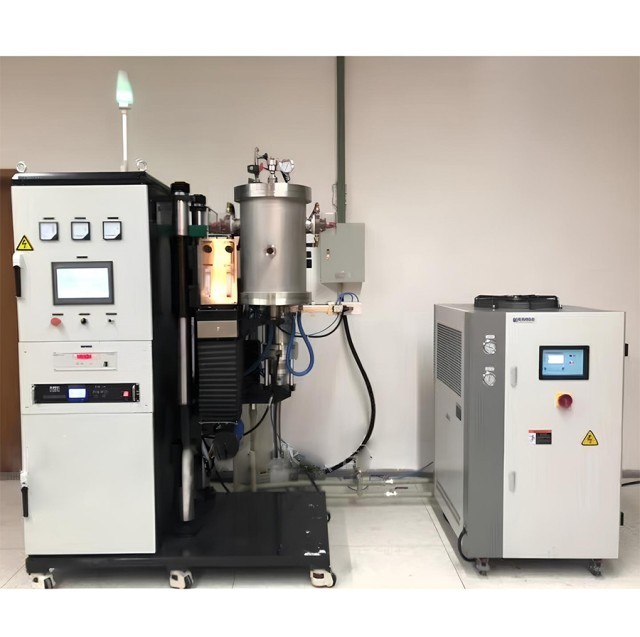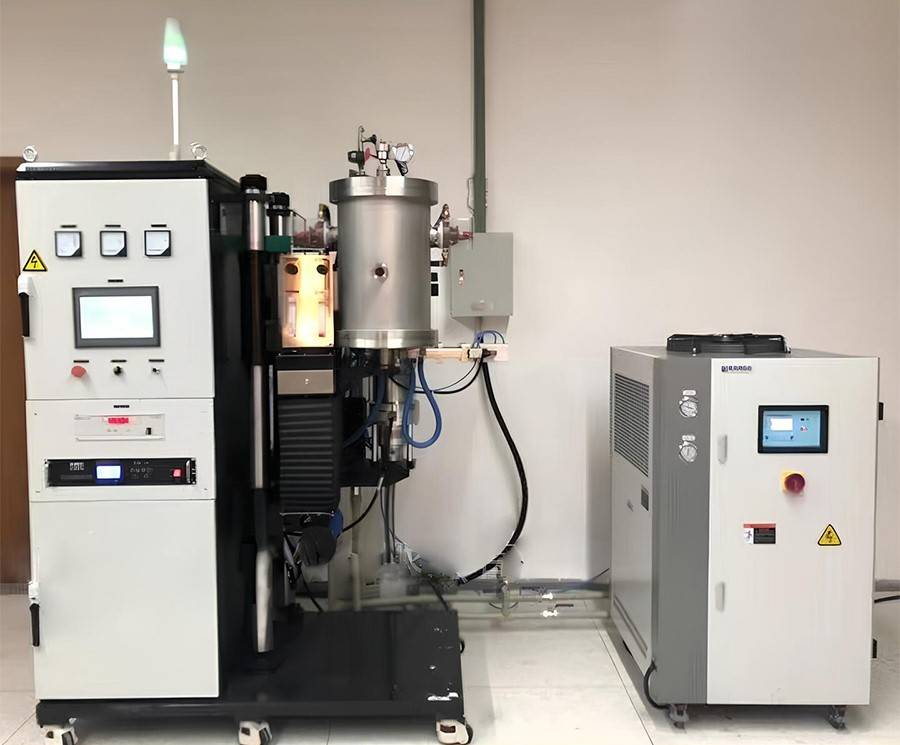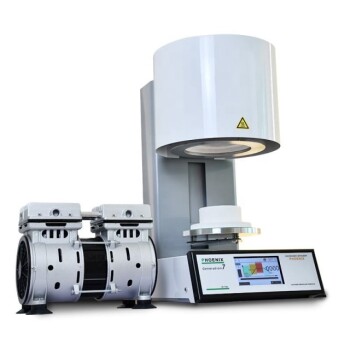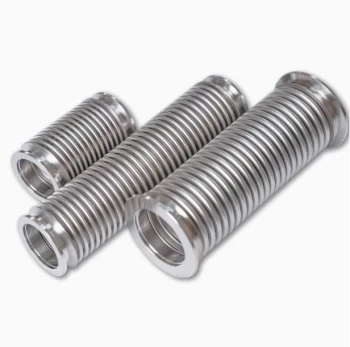
Vacuum Furnace
Vacuum Heat Treat Sintering Furnace Molybdenum Wire Vacuum Sintering Furnace
Item Number : KT-VMW
Price varies based on specs and customizations
- Maximum Temperature
- 1700℃ (Nominal 1600℃)
- Cold Ultimate Vacuum Degree
- 10^-3 Pa or 10^-4 Pa
- Furnace Temperature Uniformity
- ±5 ℃ (under vacuum)

Shipping:
Contact us to get shipping details Enjoy On-time Dispatch Guarantee.
Why Choose Us
Reliable PartnerEasy ordering process, quality products, and dedicated support for your business success.
Leveraging exceptional R&D and in-house manufacturing, KINTEK provides diverse laboratories with advanced high-temperature furnace solutions. Our product line, including Muffle, Tube, Rotary Furnaces, Vacuum & Atmosphere Furnaces, and CVD/PECVD/MPCVD Systems, is complemented by our strong deep customization capability to precisely meet unique experimental requirements.
Vacuum Molybdenum Wire Sintering Furnace

KINTEK's Vacuum Molybdenum Wire Sintering Furnace, available in vertical or horizontal configurations, is expertly designed for high-vacuum, high-temperature processes. It excels in applications such as sintering, brazing, degassing, and annealing of metal materials, as well as dehydroxylation of quartz materials. This furnace is particularly effective for processing special high-temperature materials, including tungsten and molybdenum products under a protective H2 gas atmosphere, ensuring optimal results for your critical research and production needs.
Key Features & Benefits: Achieve Superior Material Processing
- Exceptional High-Temperature Performance: Reaches up to 1700°C, ideal for demanding sintering and heat treatment processes for a wide array of materials.
- Ultra-High Vacuum Integrity: Achieves vacuum levels down to 10-4 Pa (or 10-3 Pa), creating a pristine environment that prevents oxidation and contamination, ensuring the highest material purity and quality.
- Uniform & Precise Heating: Molybdenum wire heating elements combined with advanced PLC and LCD touch screen control ensure consistent temperature distribution (±5℃ uniformity) for reliable and repeatable results.
- Robust and Efficient Design: Energy-efficient molybdenum wire heating elements offer a long service life, reducing operational costs and minimizing maintenance.
- Versatile Processing Capabilities: Suitable for sintering, brazing, degassing, annealing, and dehydroxylation across various materials, including refractory metals and ceramics.
- Protective Atmosphere Options: Supports processing under Argon, Nitrogen, or Hydrogen, providing flexibility for specific material requirements.
- Reduced Contamination: The vacuum environment effectively eliminates harmful substances like water, oxygen, and nitrogen, preventing adverse reactions such as decarburization, carburization, reduction, oxidation, and nitriding.
Versatile Applications
Our Vacuum Molybdenum Wire Sintering Furnaces are indispensable for a wide range of critical processes, including:
- Hard alloy sintering: Tungsten carbide, titanium carbide, tantalum carbide
- Ceramic materials sintering: Alumina, zirconia, silicon carbide
- Carbon fiber graphitization: For high-performance composites
- Carbon and carbon composites sintering: Aerospace, automotive, and other industries
- Silicon carbide products sintering: High-temperature applications
- Photoelectric coating materials sintering: Solar cells and optoelectronic devices
- Refractory metals sintering: Tungsten, molybdenum, tantalum
- Alloy materials sintering: Nickel-based, cobalt-based, titanium alloys
- Vacuum units sintering: Electronics, aerospace
- Electrical components sintering: Contacts, terminals, connectors
- Heating room materials sintering: Molybdenum foils
- Dehydroxylation treatment of quartz materials: Electronics, optics
Technical Specifications
| Maximum Temperature | 1700℃ (Nominal 1600℃) |
| Working Area Size (Examples) | Ф60×80 mm, Ф160×160 mm, Ф200×200 mm, Ф300×400 mm, Ф400×500 mm (Customizable) |
| Cold Ultimate Vacuum Degree | 10-3 Pa or 10-4Pa |
| Pressure Rise Rate | ≤3Pa/h |
| Power Supply | Three-phase 380 V 50 Hz (Customizable) |
| Furnace Temperature Uniformity | ±5 ℃ (under vacuum) |
| Loading and Unloading Methods | Upper, side, or bottom loading options |
| Protective Gas Options | Automatic charging and discharging for Argon, Nitrogen, Hydrogen. |
| Control Method | PLC with LCD touch screen interface |
Tailored to Your Research Needs
At KINTEK, we understand that every laboratory and research project has unique requirements. Beyond our standard configurations, we leverage our exceptional R&D and in-house manufacturing to offer strong deep customization capabilities. Whether you need specific chamber dimensions, advanced control features, or integration with other systems, our expert teams are ready to engineer a furnace solution that precisely fits your experimental goals.
Request Your Custom Furnace Solution
Ready to elevate your material processing capabilities with a furnace designed for your exact needs? Contact our specialists today to discuss your specific application and learn how our Vacuum Molybdenum Wire Sintering Furnaces can benefit your work. Please use the contact form to send us your requirements, or request a detailed quote. We look forward to partnering with you!
FAQ
What Are The Main Applications Of A Vacuum Furnace?
What Is An Atmosphere Furnace Used For?
What Is A Dental Furnace Used For?
What Is A Vacuum Induction Furnace?
What Are The Main Applications Of A Horizontal Vacuum Furnace?
What Are The Key Features Of A Vacuum Furnace?
What Are The Key Features Of An Atmosphere Furnace?
What Are The Key Features Of A Dental Furnace?
What Are The Main Applications Of Vacuum Induction Furnaces?
What Are The Key Features Of A Horizontal Vacuum Furnace?
How Does A Vacuum Furnace Work?
How Does An Atmosphere Furnace Work?
How Does A Dental Furnace Work?
How Does A Vacuum Induction Furnace Work?
How Does A Horizontal Vacuum Furnace Work?
What Are The Advantages Of Using A Vacuum Furnace?
What Are The Advantages Of Using An Atmosphere Furnace?
What Are The Advantages Of Using A Dental Furnace?
What Are The Advantages Of Using A Vacuum Induction Furnace?
What Are The Advantages Of Using A Horizontal Vacuum Furnace?
What Types Of Materials Can Be Processed In A Vacuum Furnace?
What Types Of Gases Can Be Used In An Atmosphere Furnace?
What Safety Features Should A Dental Furnace Have?
What Types Of Vacuum Induction Furnaces Are Available?
What Types Of Materials Can Be Processed In A Horizontal Vacuum Furnace?
What Is The Difference Between Hot Wall And Cold Wall Vacuum Furnaces?
What Safety Features Are Available In Advanced Atmosphere Furnaces?
What Types Of Dental Furnaces Are Available?
Why Is Temperature Control Important In Vacuum Induction Furnaces?
What Is The Temperature Range Of A Horizontal Vacuum Furnace?
Can Vacuum Furnaces Be Customized For Specific Applications?
What Materials Can Be Processed In A Vacuum Induction Furnace?
How Does The Vacuum Environment Benefit Material Processing?
4.8
out of
5
Incredible precision and durability! This furnace outperforms competitors effortlessly.
4.7
out of
5
Fast delivery and top-notch quality. Worth every penny!
4.9
out of
5
The technological advancement in this furnace is mind-blowing. Highly recommend!
4.8
out of
5
Superior build and performance. A game-changer for our lab!
4.9
out of
5
Efficient and reliable. Exceeded all our expectations!
4.7
out of
5
Perfect for high-temperature applications. Delivered faster than expected!
4.8
out of
5
Exceptional value for money. The quality is unmatched!
4.9
out of
5
This furnace is a beast! Handles everything we throw at it with ease.
4.7
out of
5
Impressive technology and sturdy construction. A solid investment!
4.8
out of
5
The molybdenum wire design is brilliant. Works flawlessly every time!
4.9
out of
5
Fast, efficient, and built to last. Couldn’t be happier!
4.7
out of
5
Perfect for sintering applications. Delivery was lightning fast!
4.8
out of
5
High-quality materials and advanced features. A must-have!
4.9
out of
5
This furnace is a powerhouse! Delivers consistent results every time.
4.7
out of
5
Great investment for any lab. The performance is stellar!
4.8
out of
5
Robust and reliable. Exceeded our expectations in every way.
4.9
out of
5
Cutting-edge technology and superb craftsmanship. Highly satisfied!
REQUEST A QUOTE
Our professional team will reply to you within one business day. Please feel free to contact us!
Related Products

Vacuum Heat Treat Sintering Furnace with Pressure for Vacuum Sintering
KINTEK's Vacuum Pressure Sintering Furnace offers 2100℃ precision for ceramics, metals, and composites. Customizable, high-performance, and contamination-free. Get a quote now!

600T Vacuum Induction Hot Press Vacuum Heat Treat and Sintering Furnace
600T Vacuum Induction Hot Press Furnace for precise sintering. Advanced 600T pressure, 2200°C heating, vacuum/atmosphere control. Ideal for research & production.

Small Vacuum Heat Treat and Tungsten Wire Sintering Furnace
Compact vacuum tungsten wire sintering furnace for labs. Precise, mobile design with superior vacuum integrity. Ideal for advanced material research. Contact us!

9MPa Air Pressure Vacuum Heat Treat and Sintering Furnace
Achieve superior ceramic densification with KINTEK's advanced air pressure sintering furnace. High-pressure up to 9MPa, precise 2200℃ control.

Vacuum Heat Treat Sintering and Brazing Furnace
KINTEK Vacuum Brazing Furnaces deliver precision, clean joints with superior temperature control. Customizable for diverse metals, ideal for aerospace, medical, and thermal applications. Get a quote!

Vacuum Heat Treat Furnace with Ceramic Fiber Liner
KINTEK's Vacuum Furnace with Ceramic Fiber Lining offers precise high-temperature processing up to 1700°C, ensuring uniform heat distribution and energy efficiency. Ideal for labs and production.

Molybdenum Vacuum Heat Treat Furnace
High-performance molybdenum vacuum furnace for precise 1400°C heat treatment. Ideal for sintering, brazing, and crystal growth. Durable, efficient, and customizable.

Dental Porcelain Zirconia Sintering Ceramic Vacuum Press Furnace
Precision Vacuum Press Furnace for labs: ±1°C accuracy, 1200°C max, customizable solutions. Boost research efficiency today!

Vacuum Dental Porcelain Sintering Furnace for Dental Laboratories
KinTek Vacuum Porcelain Furnace: Precision dental lab equipment for high-quality ceramic restorations. Advanced firing control & user-friendly operation.

Vacuum Hot Press Furnace Machine Heated Vacuum Press
KINTEK Vacuum Hot Pressing Furnace: Precision heating & pressing for superior material density. Customizable up to 2800°C, ideal for metals, ceramics, and composites. Explore advanced features now!

Vacuum Hot Press Furnace Machine Heated Vacuum Press Tube Furnace
Discover KINTEK's advanced Vacuum Tube Hot Press Furnace for precise high-temperature sintering, hot pressing, and material bonding. Customizable solutions for labs.

High Pressure Laboratory Vacuum Tube Furnace Quartz Tubular Furnace
KINTEK High Pressure Tube Furnace: Precision heating up to 1100°C with 15Mpa pressure control. Ideal for sintering, crystal growth, and lab research. Customizable solutions available.

Vacuum Induction Melting Furnace and Arc Melting Furnace
Explore KINTEK's Vacuum Induction Melting Furnace for high-purity metal processing up to 2000℃. Customizable solutions for aerospace, alloys, and more. Contact us today!

High Performance Vacuum Bellows for Efficient Connection and Stable Vacuum in Systems
KF ultra-high vacuum observation window with high borosilicate glass for clear viewing in demanding 10^-9 Torr environments. Durable 304 stainless steel flange.